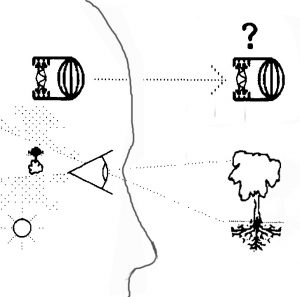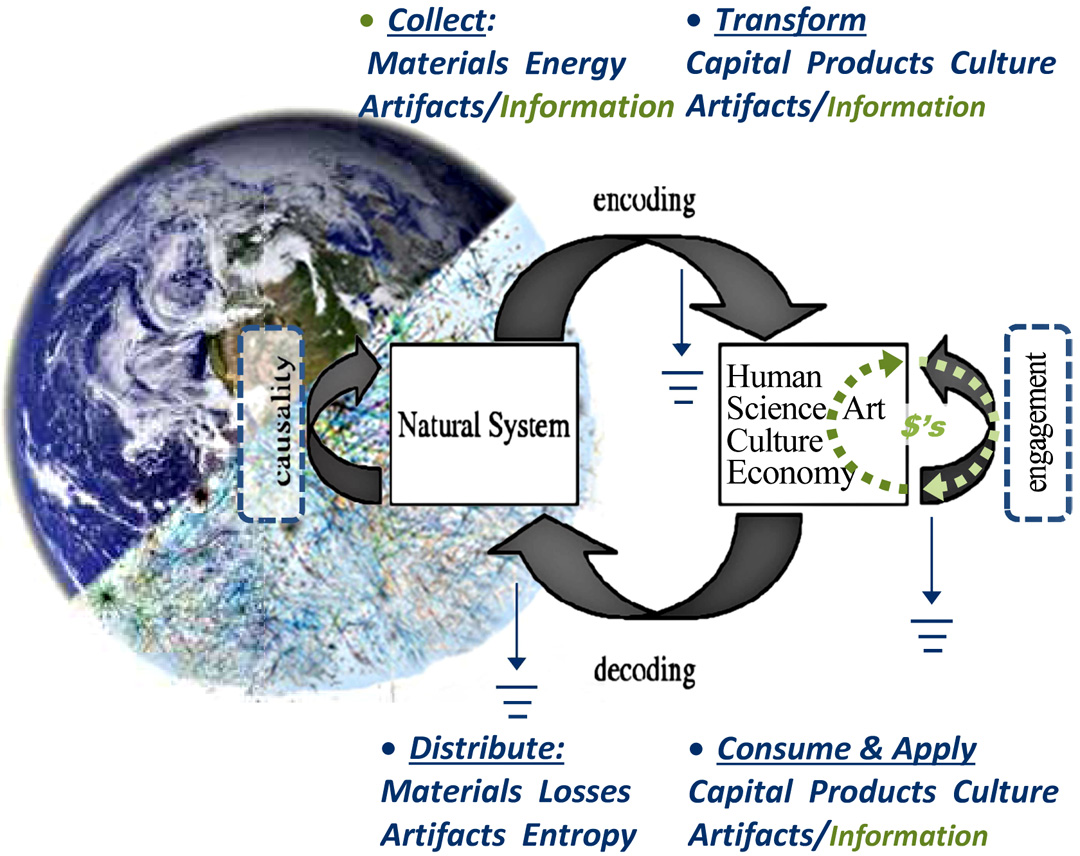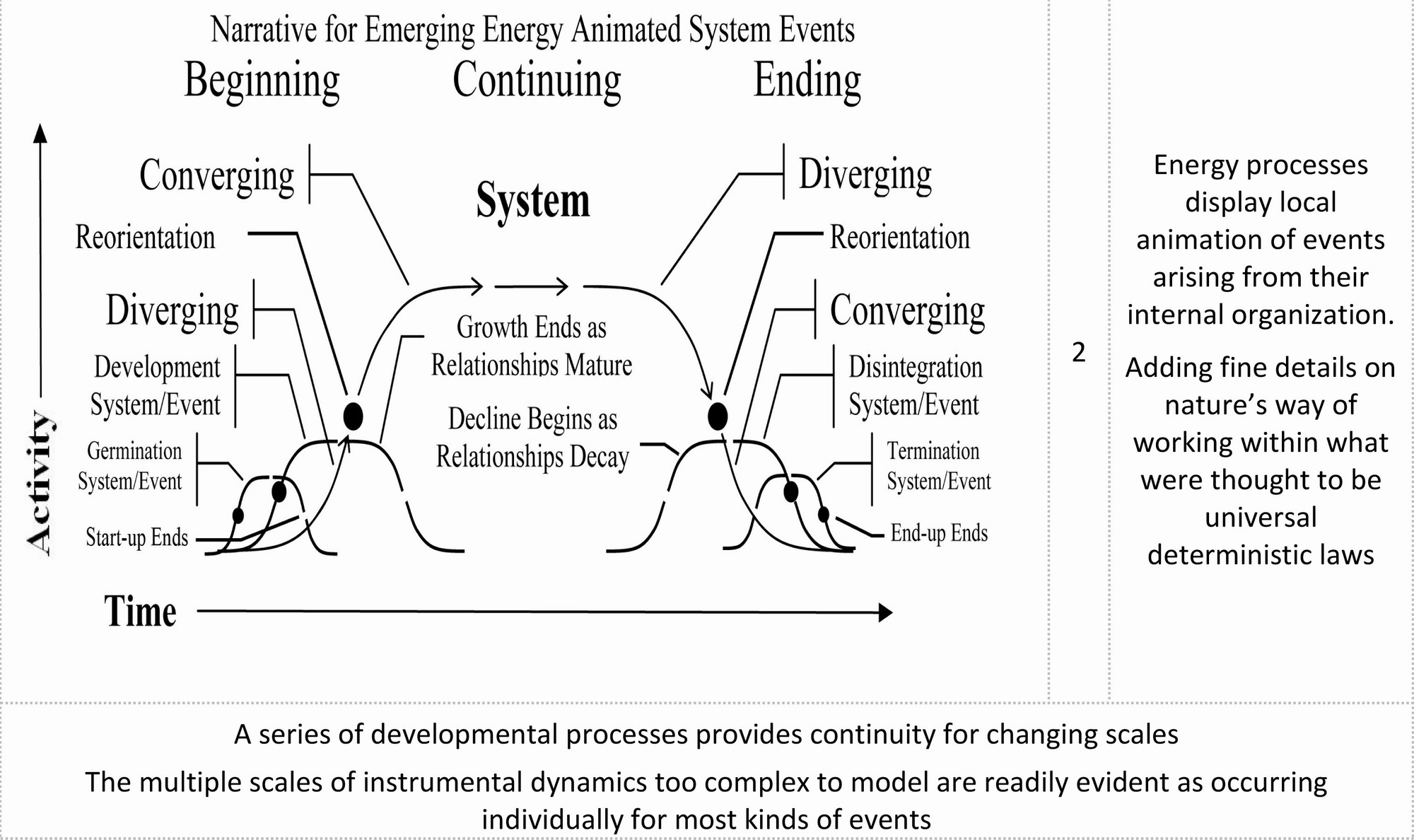Jessie Lydia Henshaw’s World
Basic Introduction to the ideas and methods
See recent YouTube talks, Papers, and Posts for new advances.
For those new to my work, the general approach is to use fairly simple scientific explanatory principles, like ‘scale,’ ‘acceleration’, ‘energy,’ and ‘boundaries,’ and ‘organization’ just as used for referring to and describing specific observable things, not as abstract ideas or theories, but as references to what is naturally material about what we observe.
Theories are still very useful, but the subject here is not mainly the theory but the material origins, designs, and behaviors of the natural world we’re part of. That use of theory to observable features of natural subjects is needed to make the study one of how nature works by itself, which turns out to be very different than how science has usually described it, somewhat like interpreting science as a craft. Ask a different question, you get a different answer.
It’s to help with identifying and discussing things in context rather than as abstracted from their contexts, things natural language developed to communicate and store as information on how the world lives, rather than as it theoretically should, a big difference quite often. It greatly helps raise better questions about how the natural systems in our surroundings are organized and behave. For example, one can observe a business as an organization of various specialized work groups, along with the technologies the people are most expert in using. Those work groups are served and guided by management to work together as a whole. So the idea is to say quite a lot just by speaking clearly, using natural language, to then better see the systems behind the data if you can imagine what’s happening.
We’ve actually done that for the last half million years at least, as our way of getting along, unable to make up theories but absorbing lots of useful direct knowledge about how things work independently and creating many useful languages for sharing what we learned and passing it along, adding sophistication. We naturally look at the plants that way things connected to things, with internal working parts, in a way that equations really cannot explain.
The same with ecologies or cultures working all together, composed of families and populations in their environments. They’re all “organizations of specializations” in that every part finds its own role in its local context, environment, and community, so each can work together, “unified by their design to “work as a whole.” If you see things working as a whole, it amounts to recognizing their mutual coordination, the distinct differences between what goes on inside their unified relationships and outside, and asking how the system developed.
One usually finds it developed from some starting pattern, it’s ‘seed’ or ‘germ’ or ‘model’ by one or another process of growth. All those traits and many more seem to generally go along with “systems”, as the complex units of design that populate our world. What’s different about this view from the usual scientific approach is that it’s a study of individual designs as things actively working in our environment.
The scientific method begins with data and ends with finding equations for predicting the average behaviors of things. Here, the focus tends to begin and end with finding good questions to ask about how things are designed and work individually. It’s often useful as well to be able to go back and forth between those two scientific views, and from the views of other disciplines too, all addressing the natural subjects in common.
lso look at the designs of plants that way, or think of ecologies or cultures working that way, composed of families and populations in their environments. They’re all “organizations of specializations” that are “unified by a design” for working as a whole. If you see things working as a whole, it amounts to recognizing the boundary enclosing it, noticing distinct differences between what goes on inside and outside, and asking how the system developed. One usually finds it developed from some starting pattern, it’s ‘seed’ or ‘germ’ or ‘model’ by one or another process of growth. All those traits and many more seem to generally go along with “systems”, as the complex units of design that populate our world. What’s different about this view from the usual scientific approach is that it’s a study of individual designs as things working in our environment. The scientific method begins with data and ends with finding equations for predicting the average behaviors of things. Here the focus tends to begin and end with finding good questions to ask about how things are designed and work individually. It’s often useful as well to be able to go back and forth between those two scientific views, and from the views of other disciplines too, all addressing the natural subjects in common.

__________
In 2014-15, I pursued what seemed like a wonderful new opening.
A chance to join my pattern recognition for natural system designs with the “pattern language” for holistic design of Christopher Alexander. It gives me a wonderful way of recording and communicating to create a whole language of “how to work with nature” by recognizing nature’s working parts, closely coordinated with the language of Christopher Alexander and how it is being adopted by a number of professions as a common language of holistic design. Alexander’s ‘pattern language’ originated as his way of documenting the ancient principles of holistic architectural design, using a practice of being explicit about the “context”, the “forces” needing a response, and “simplifying ideals” of the designs to unify them, along with lists of the expert knowledge needed to communicate and accomplish it, a holistic language of design.
The profession that has applied it most widely is software programmers, using it as a formal way to define whole working parts of programs as having holistic designs and purposes, often called “object-oriented programming”. Describing natural systems as whole units of organization, I sometimes call “object-oriented science” as a study of how natural systems work as wholes. There’s no real change in my former scientific methods for recognizing natural patterns of design in how energy systems behave as wholes. How I use my “Patterns of Naturally Occurring Design” is mainly a rich new way to use natural language to discuss the holistic designs of nature. Natural language refers to our social values, but we also need to understand and work with it as part of our natural world. They’re a bit advanced in that sense, but I also think I’ve laid out a natural way to expand on our common knowledge to work with Alexander’s approach to holistic design, not just for new ways to work on nature but also the new ways that will eventually transform our ways of working with nature. At this point, the introduction is to browse my two papers, one for PURPLSOC and the other for PLop 2015, on “Elements” and “Mining Living Quality“.
what seems like a wonderful new opening to join my pattern recognition for natural system designs with the “pattern language” for holistic design of Christopher Alexander. It gives me a wonderful way of recording and communicating to create a whole language of “how to work with nature” by recognizing nature’s working parts, closely coordinated with the language of Christopher Alexander and how it is being adopted by a number of professions as a common language of holistic design. Alexander’s ‘pattern language’ originated as his way of documenting the ancient principles of holistic architectural design, using a practice of being explicit about the “context”, the “forces” needing response and “simplifying ideals” of the designs to unify them, along with lists of the expert knowledge needed to communicate and accomplish it, a holistic language of design.
The profession that has applied it most widely is software programmers, using it as a formal way to define whole working parts of programs as having holistic designs and purposes, and often called “object-oriented programming”. Describing natural systems as whole units of organization, I sometimes call “object-oriented science” the study of how natural systems work as wholes. There’s no real change in my former scientific methods for recognizing natural patterns of design in how energy systems behave as wholes. How I use my “Patterns of Naturally Occurring Design” is mainly a rich new way to use natural language to discuss the holistic designs of nature. Natural language refers to our social values, but we also need to understand and work with it as part of our natural world.
My 2012 to 2014 work was mostly on Sustainable Development and the UN’s SD goals…
It was exciting but also totally frustrating to find and describe the various great conceptual misunderstandings of how natural systems work and describe some as technical problems with possible solutions. See my RNS journal entries for that period for the details.
Intro to work on natural systems 1978 to 2011:
The discussion focuses on the “natural systems paradigm” of science. It expands on the scientific method to correct a major omission. The scientific method was never designed to study the self-organizing systems of nature in their natural form.
Natural systems could only be studied as abstract models invented by scientists based on equations built around recorded observations. The lack of observations on how natural systems work internally is the problem. As for another person’s life or mind, you simply can’t tell how things that work by themselves are organized and operated from their own insides. Nature abounds with such systems, but the lack of data on how they work has forced science to simply ignore them as a subject of study.
My approach rests on using observation to first locate natural systems by how they work as a whole and then investigate their stages of evolution from beginning to end.
They’re a bit advanced in that sense, but I also think I’ve laid out a natural way to expand on our common knowledge to work with Alexander’s approach to holistic design, not just for new ways to work on nature but also the new ways that will eventually transform our ways of working with nature. At this point, the introduction is to browse my two papers, one for PURPLSOC and the other for PLop 2015, on “Elements” and “Mining Living Quality“.

___________
My 2012 to 2014 work was mostly on Sustainable Development and the UN’s SD goals…
It was quite exciting but also terribly discovering and trying to describe the various great conceptual misunderstandings of how the natural systems work that the work was to change, citing key technical problems with possible solutions. See my RNS journal entries for that period for the details.
Intro to work on natural systems 1978 to 2011:
The discussion focuses on the “natural systems paradigm” of science. It expands on the scientific method to correct a major omission. The scientific method was never designed to study the self-organizing systems of nature in their natural form.
Natural systems could only be studied as abstract models invented by scientists based on equations built around recorded observations. The lack of observations on how natural systems work internally is the problem. As for another person’s life or mind, you simply can’t tell how things that work by themselves are organized and operated from their own insides. Nature abounds with such systems, but the lack of data on how they work has forced science to simply ignore them as a subject of study.
My approach rests on using observation to first locate natural systems by how they work as a whole and then investigate their stages of evolution from beginning to end.
It’s both serious physics and richly informed “storytelling” using natural language and the universal themes of beginnings and ends of change. It uses the principle of energy conservation as the common natural limit for all energy-using processes to explore natural systems and events. The “epidemiological” device used is that of a “dual reality”, treating words like “apple” to refer to both the thing and the idea of an apple. That allows discussion to refer to *both* subjects defined by nature and those of abstract definition in our minds (the world of nature and the world of intellect) as “hand and glove” to consider how one’s mental and physical worlds fit.
So it’s not about “data and equations” so much as about observed “whole units of organization” found in nature (individual systems). Studying how self-organized systems behave as a whole is the only way to tell how the behaviors of their parts are adding up. Abstract theories simply have no source of data for their interior workings.
Posts on current issues are mostly from a view of general principles,
…so old posts are often out of date for learning more about what is going on behind the scenes when observing environmental events in action.
Nature’s working parts are not “facts” but self-defining physical systems, objects of nature that exist independent of our facts. They work by themselves, where they are, in ways that are far too complex and too holistic for us to define with abstract rules.
You don’t need to know quite how systems work, where how they work as a whole is simple enough to understand by itself.
Natural systems one can clearly identify as individual “things” are generally found to have developed by an energy-using growth process from some “seed” or other “germ of organization. Each then develops by growing in its own environment, usually in a unique local way. Biological organisms are energy using systems that mostly develop by growth from a seed. Thinking of all natural systems from how they work as a whole, as if like “organisms” that work by themselves, living out a natural life, is one convenient way.
So, I studied “storms” as locally developing systems for moving heat, for example, rather than as following rules of deterministic processes. My study of the physics of change over time directed me to prove that this was a necessary perspective. The illusion that systems are organizational, not deterministic, to have flowing reorganization smooth enough to satisfy the conservation of energy from beginning to end. [drtheory.pdf]
The familiar paradigm of modern science, so far, does not recognize the existence of self-managing systems in nature. Its only subject of science is “our systems” of mathematical relations, ones we invent to explain the data we collect. So, my work also had to become an exploration of the role of science in shaping our thinking, as the earth and other physical systems of everyone’s great direct concern turn out not to be directly studied by science.
So what I actually study are systems exhibiting the behaviors of individual growing and evolving organisms, storms, events, cultures, transformations, emergence, dances, bursts of change, and collapses of self-organization, etc. They develop by their own processes. Their “cellular design” (having different sets of internal and external relationships) comes from how they develop, extending the patterns of an animated central ‘kernel” of design that builds onto itself as it finds resources and forms internal and external relationships.
It’s observed as a burst of self-organization as a new pattern of energy use expands in its environment. It’s been a struggle to get “deterministic thinkers” to consider “opportunistic processes”, though. So, the chance to organize and present my rather well-founded theoretical/empirical approach has been put off for decades, actually. I keep trying to use “English,” but am also clearly not yet finding a language to convey it.
It’s not that “physics is wrong” but rather that it takes a different approach, looking at the parts of nature that can be successfully described as following universal rules. I study the parts of nature that can be successfully described as following locally developing rules. The two sets of explanatory principles can and do work together and expand our awareness of what’s happening within and around us.
Most of the posts from my old blog have been moved here, with a quick edit or two for some in the process. There’s lots of good stuff going all the way back to 2006. My research archive is Synapse9.com, the work of P.F. Henshaw (my pen name).
ed: Jan 2024


Your approach has incredible impact, if only people will begin to realize the simple approach to self-organizing systems and begin to realize the opportunity in that. However, I also find there is an ethical dilemma when it comes to implementing these concepts in pursuit of productivity. Best utilized on a self-sufficiency and educational regard, this way of thinking in the hands of the wrong corporations in pursuit of money could further perpetuate the pickle that the world is in.
These are just a few brief thoughts of your work. I am exploring adjacent realms myself currently seeking primarily truly sustainable human living while operating as an industrial engineer and exploring adjacent realms like HR development and cybernetics.
Iteration, bifurcation
Divide repeatedly
Life itself and all else
Is created fractal
and possesses intense modularity
Allen, It sounds like you’re looking around, which is great. I don’t think the problem is so much the “wrong businesses” as the “wrong investors,” as that is where the growth imperative and its ever-multiplying damage to the earth seem to come from. So the question is why are they seemingly blind to it???